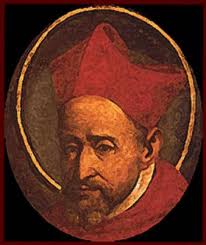St Cajetan (1480-1547) was, like his contemporary Martin Luther, deeply concerned by the worldliness and decadence he saw among the clergy. He, however, sought to reform the Church from within, founding the Order of the Theatines.
This was the first congregation of regular clergy. Its aims were to preach sound doctrine, to tend the poor and the sick, to restore frequent use of the sacraments and to inspire better priestly conduct.
Born into the nobility of Vicenza as Gaetano dei Conti di Tiene, Cajetan lost his father at two. His mother brought him up to be both studious and devout.
After becoming a doctor in civil and canon law at Padua in 1504, he was protonotary to Pope Julius II in Rome from 1506 to 1513. Ordained in 1516, he returned to Vicenza two years later.
In Rome he had been associated with a group of zealous clergy styling themselves the Oratory of Divine Love. Back in Vicenza, he entered the Oratory of St Jerome and founded a hospital for incurables.
“In the Oratory,” he said, “we try to serve God by worship; in our hospital we may say that we actually find Him.” He went on to create hospitals in Verona and Venice.
Distressed by what he saw of the clergy, Cajetan returned to Rome in 1523 to confer with his friends in the Oratory of Divine Love. These included Pietro Carafa, Bishop of Chieti, a fiercely intransigent prelate who would be elected Pope Paul IV in 1555. With Carafa, Cajetan established in 1524 a new order, naming them the Theatines, after the Latin name for Chieti (Theate Marricinorum). There was particular emphasis on poverty and on thorough biblical training.
Carafa became the first superior-general, though Cajetan filled that office from 1530 to 1533. Perhaps due to Carafa’s uncompromising nature, the order did not immediately flourish. Moreover, it had to flee to Venice when the Emperor Charles V sacked Rome in 1527.
After 1533 Carafa sent Cajetan first to Verona, and then to Naples, where the Theatines gradually became respected for their stand against the city’s corruption and indifference to the poor. Cajetan established pawnshops which were run purely for the benefit of their users.
Among the Theatines at Naples from 1547 was the Englishman Thomas Goldwell, who had fled from Henry VIII’s regime. In 1555, under Queen Mary, he was appointed Bishop of Asaph, before once again being obliged to leave England under Queen Elizabeth. From 1561 Goldwell was briefly superior-general at Naples. He would live to be the last survivor of Mary’s bishops.
For 250 years the Theatines flourished in western Europe, as well as conducting foreign missions. In the 19th century, however, they fell into decline. In 2005 they numbered only some 200 religious, mainly in Spain and South America.
